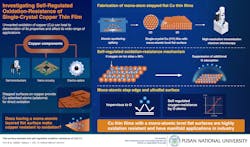Copper is the most commonly used metal in the electronics industry, thanks to its excellent conductivity and ability to be drawn into thin wire. But it does corrode, which forms copper oxide on its surface, degrading that conductivity and limiting its life as a conductor.
That could be a thing of the past if research by a team of engineers at Pusan National University and Mississippi State University can be commercialized. It developed a method of fabricating atomically flat single-crystal copper films with semi-permanent oxidation-resistance. It also discovered how those oxides form on copper.
Previous studies showed that copper (Cu) oxides due to microscopic “multi-steps” on the surface of copper. These steps provide a source of Cu adsorbed atoms which interact with oxygen and provide a place for oxides to grow. To prevent this, the team used atomic sputtering epitaxy to grow flat, tightly coordinated, single-crystal copper films. The researchers had to use high-tech noise reduction to reduce electrical and mechanical interference to keep the Cu surfaces nearly defect-free and fabricate the atomically flat films.
The research team used high-resolution transmission electron microscopy to study the films and found that the film had an almost flat surface with occasional mono-atomic steps. They also compared their single-crystal Cu films (SCCFs) with other Cu films with more surface roughness. They found that unlike the other films, SCCFs were oxidation-resistant because it is difficult for oxygen to penetrate the mono-atomic step edges.
The researchers then used a microscopic model of Cu oxidation based on “density functional theory” to investigate how the SCCF interacts with oxygen. They found that the SCCF’s surface was protected by oxygen itself once 50% of its surface was covered with oxygen atoms.
“Oxidation-resistant Cu films could potentially replace gold in semiconductor devices, which would help bring down their costs. Oxidation-resistant Cu could also reduce electrical consumption, as well as increase the lifespan of devices with nanocircuitry,” says Professor Se-Young Jeong, one of the lead researchers.

